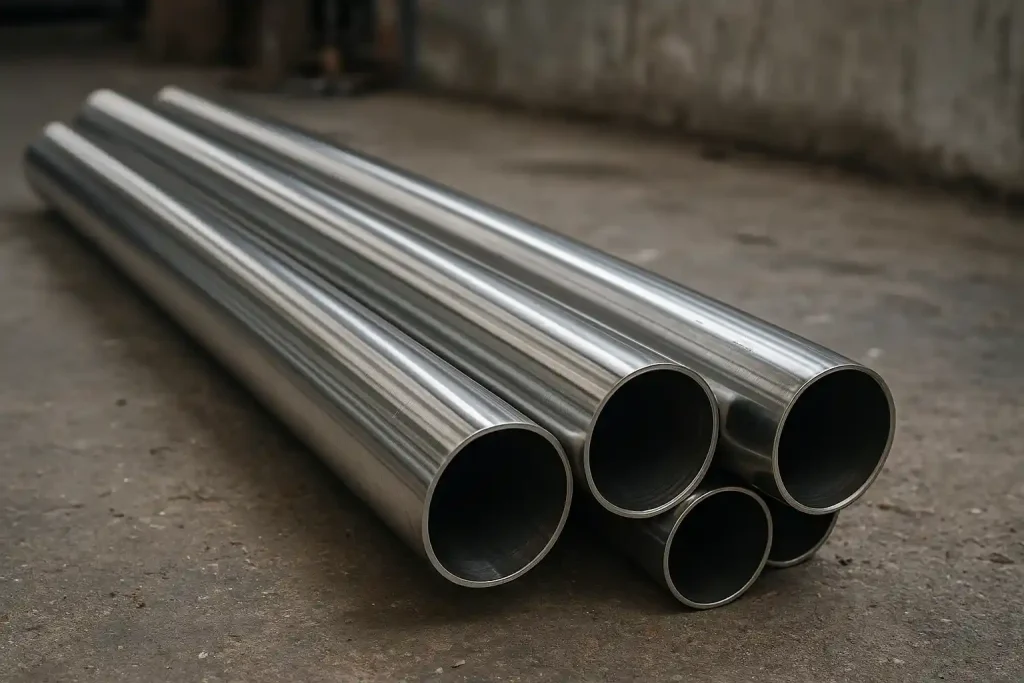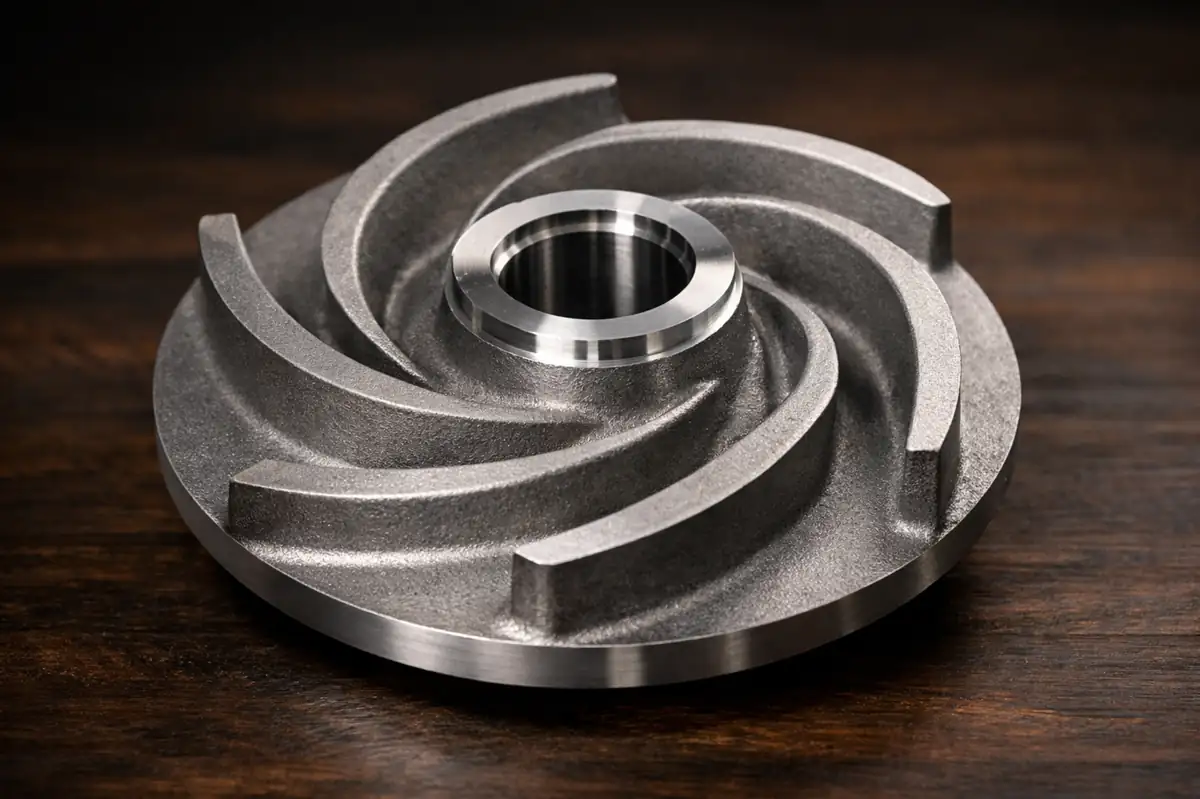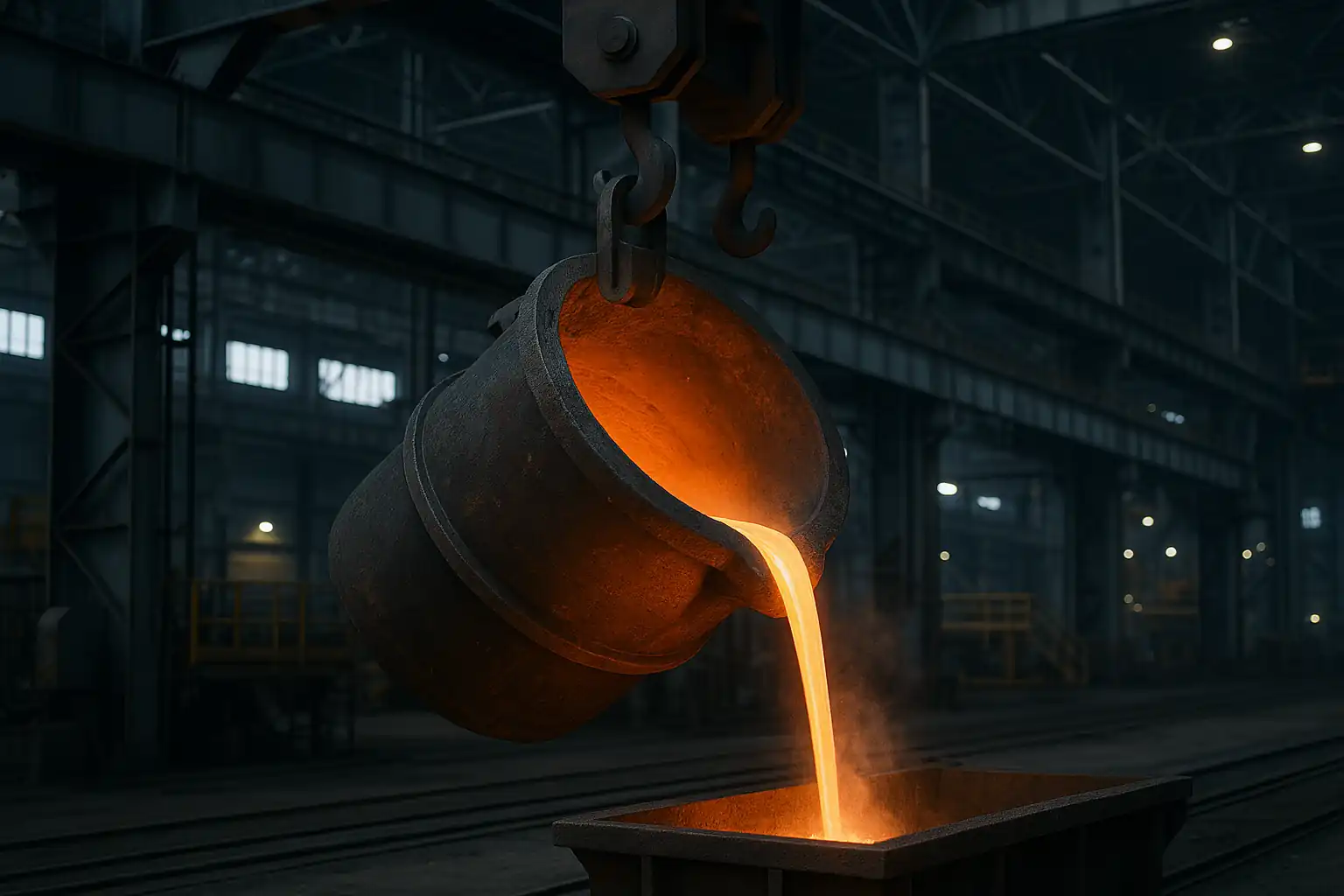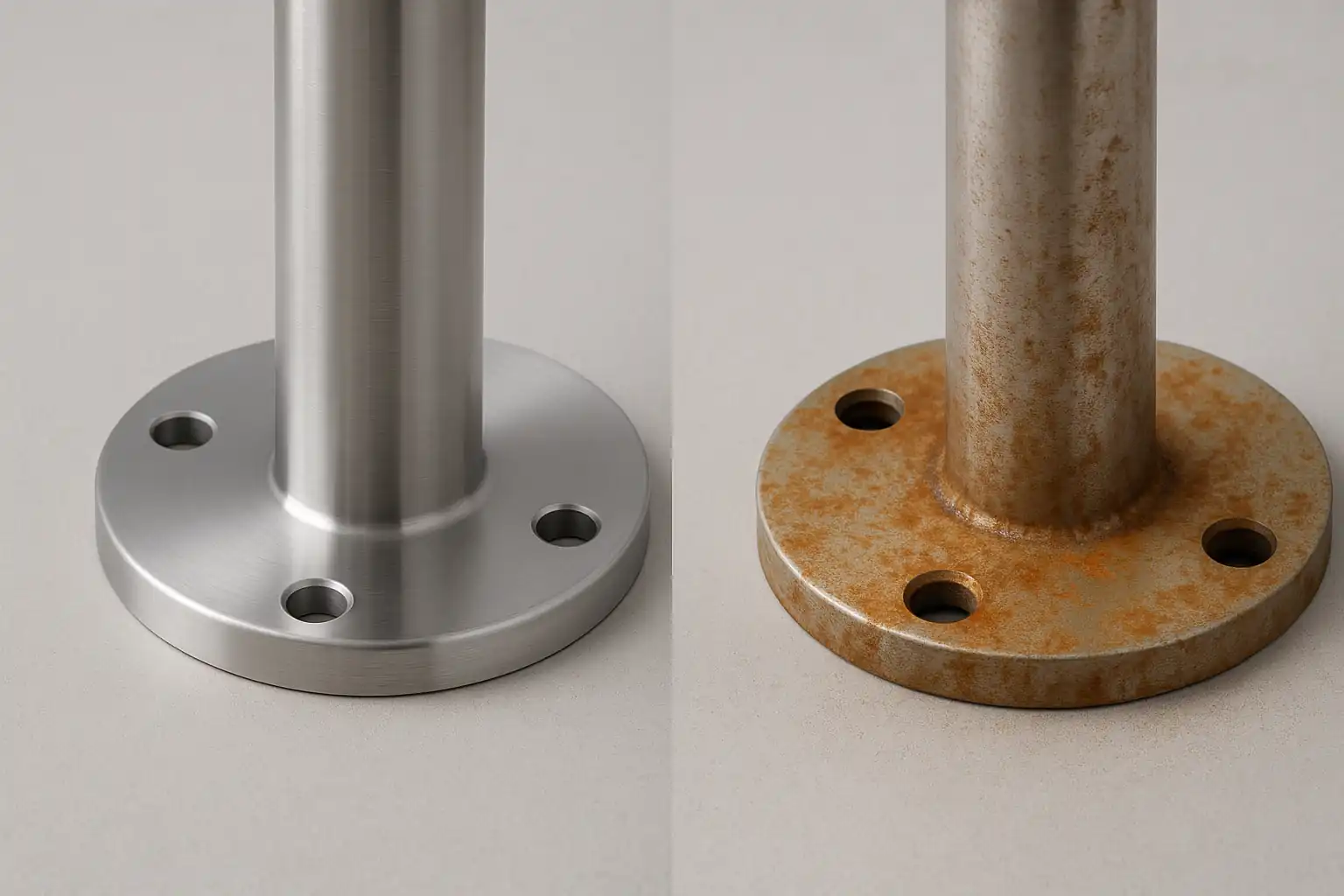Stainless steel is defined as a group of corrosion-resistant iron–chromium alloys (Fe–Cr alloys) containing a minimum of 10.5% Cr. The chromium forms a passive oxide layer that protects the base metal from corrosion.

Comprehensive classification of cast stainless steel alloys, detailing types such as Austenitic, Ferritic, Martensitic, Duplex, Precipitation Hardening, and Heat-Resistant steels, along with their respective alloy designations.
This guide lists the six major types and 43 common grades of stainless steel relevant to the foundry industry, detailing their typical composition, mechanical and corrosion properties, and primary casting applications. The listed grades relate to common industry standards for steel castings, including ASTM A743/A744/A890 (US), EN 10283 (Europe), and GB/T (China). Cast grades often have modified compositions compared to their wrought equivalents to optimize casting, weldability, and corrosion resistance through control of elements like carbon, silicon, and delta ferrite.
Austenitic Stainless Steels (CF Series)
Austenitic stainless steels are the most widely used group, characterized by a face-centered cubic (FCC) crystal structure. They are non-magnetic, possess excellent weldability, high ductility, and outstanding general corrosion resistance. In casting, $\delta$-ferrite content must be carefully controlled (typically 3%–30%) to prevent hot tearing and enhance weldability.
| Grade | Typical Composition | Properties | Typical Casting Applications |
| 201 | Low Ni (~4–5.5% Ni), high Mn (5.5–7.5% Mn), 16–18% Cr | High work-hardening rate; good corrosion resistance for mild environments. | Food service equipment, structural parts in mild environments. |
| 202 | Low Ni (~4–6% Ni), high Mn (7.5–10% Mn), 17–19% Cr | Similar to 201 but slightly lower ductility; moderate corrosion resistance. | Architectural trim, non-critical process components. |
| 301 | ~17% Cr, 7% Ni, 0.15% C max | High strength when cold worked; good corrosion resistance. | Structural components, spring applications. |
| 302 | ~18% Cr, 8% Ni, 0.15% C max | General purpose grade; good ductility and corrosion resistance. | Covers, housings, general purpose fittings. |
| 303 | ~18% Cr, 8% Ni, S/Se added | Increased machinability due to sulfur/selenium; reduced corrosion and weldability. | Threaded connectors, parts requiring extensive machining. |
| 304 / CF8 | ~18–20% Cr, 8–11% Ni, 0.08% C max | Excellent general corrosion resistance; highly ductile and weldable; susceptible to carbide precipitation at 425–870 degC. | Pump bodies, valve casings, pipe fittings, flanges. |
| 304L / CF3 | ~18–20% Cr, 8–12% Ni, 0.03% C max | Reduced carbon minimizes sensitization and intergranular corrosion; excellent weldability without post-weld heat treatment (PWHT). | Welded components, chemical processing equipment, cryogenic service. |
| 316 / CF8M | ~16–18% Cr, 10–14% Ni, 2–3% Mo, 0.08% C max | Molybdenum addition provides superior resistance to pitting and crevice corrosion, especially in chlorides. | Marine hardware, chemical/pulp/paper industry valves and pumps. |
| 316L / CF3M | ~16–18% Cr, 10–14% Ni, 2–3% Mo, 0.03% C max | Low carbon with Mo enhances pitting resistance and excellent post-weld corrosion resistance. | Food processing equipment, pharmaceutical reactors, aggressive chemical environments. |
| 316Ti | ~17% Cr, 12% Ni, 2.5% Mo, Ti stabilized | Titanium addition stabilizes carbon, improving high-temperature strength and sensitization resistance. | Components operating at elevated temperatures (up to 550 degC). |
| 321 | ~17% Cr, 10.5% Ni, Ti stabilized | Titanium stabilizes carbon, preventing intergranular corrosion after exposure to 425–870 degC. | Aircraft parts, exhaust manifolds, components in thermal cycling. |
| 347 | ~18% Cr, 11% Ni, Nb/Ta stabilized | Niobium/Tantalum stabilization for improved intergranular corrosion resistance in the sensitization range. | High-temperature pressure vessel parts, heat exchangers. |
| 904L (cast eq.) | ~20% Cr, 25% Ni, 4.5% Mo, low C, 1.5% Cu | Very high resistance to sulfuric acid and chloride stress corrosion cracking; fully austenitic. | Seawater equipment, pollution control scrubbers. |
| CF8C | ~19% Cr, 10% Ni, Nb/Ta stabilized | Niobium/Tantalum stabilization, similar to 347, for cast components requiring high-temperature strength and post-weld corrosion resistance. | High-pressure steam valves, power generation equipment. |
Ferritic Stainless Steels (CB / CC Series)
Ferritic stainless steels contain high chromium and low or zero nickel, giving them a magnetic structure. They offer good resistance to stress corrosion cracking and oxidation at elevated temperatures. They are generally less strong and less weldable than austenitic grades.
| Grade | Typical Composition | Properties | Typical Casting Applications |
| 405 | 11.5–13.5% Cr, $0.2\% \text{Al}$, low C | Aluminum reduces hardening; good weldability; modest corrosion resistance. | Furnace parts, annealing boxes. |
| 409 / CB30 / CC50 | 11.5–13% Cr, Ti/Nb stabilized, low C | Good oxidation resistance; suitable for high temperatures; mild corrosion resistance. | Automotive exhaust systems, heat exchangers. |
| 410L | 11.5–13.5% Cr, low C | Lower strength than 410; good ductility and formability; resists mild atmospheric corrosion. | Structural components in mild environments. |
| 430 (cast eq.) | 16–18% Cr, low Ni | Good ductility and resistance to nitric acid; moderate corrosion and heat resistance. | Decorative trim, non-critical parts in chemical processes. |
| 434 (cast eq.) | 16–18% Cr, 1% Mo | Molybdenum improves pitting resistance; good heat resistance. | Automotive trim, appliances, hot water tanks. |
| 436–444 (cast eq. range) | 16–26% Cr, Mo/Nb/Ti (higher Cr, Mo for better corrosion) | Excellent resistance to pitting and crevice corrosion; high temperature strength and oxidation resistance. | High-temperature combustion parts, more aggressive aqueous environments. |
Martensitic Stainless Steels (CA Series)
Martensitic stainless steels are hardenable by heat treatment (quenching and tempering) to achieve high strength, hardness, and wear resistance. They are magnetic and generally have a lower chromium content than ferritic grades, resulting in lower general corrosion resistance.
| Grade | Typical Composition | Properties | Typical Casting Applications |
| CA15 (approx 410) | 11.5–14% Cr, max 1.0% Ni, 0.15% C max | Hardenable to high strength; moderate corrosion resistance; good abrasion resistance. | Valve trim, pump impellers, steam turbine blades. |
| CA6NM (13Cr-4Ni) | 11.5–14% Cr, 3.5–4.5% Ni, low C, 0.5–1.0% Mo | Excellent combination of high strength, toughness, and good weldability; resistance to stress corrosion cracking. | Hydroelectric turbine runners, high-pressure valves. |
| CA40 (approx 420) | 11.5–14% Cr, 0.20–0.40% C | Higher carbon than CA15 allows for higher hardness and wear resistance; requires tempering after casting/welding. | Hard-wearing valve components, knife blades. |
| 410 | 11.5–13.5% Cr, 0.15% C max | Basic heat-treatable grade; good ductility; moderate corrosion resistance. | Fasteners, general mechanical parts. |
| 416 | 12–14% Cr, S/Se added | Free-machining version; reduced corrosion resistance and weldability. | Parts requiring high machining volumes (e.g., shafts). |
| 420 | 12–14% Cr, 0.15% C min | Higher carbon for better hardness and strength; requires proper heat treatment. | Surgical instruments, shear blades, wear plates. |
| 431 | 15–17% Cr, 1.25–2.5% Ni | Good corrosion resistance and high strength; less hardenable than 420. | Shafts, bolts, valve spindles. |
| 440A | 16–18% Cr, 0.60–0.75% C | High carbon content for very high hardness and wear resistance. | Cutlery, bearings, wear-critical parts. |
| 440B | 16–18% Cr, 0.75–0.95% C | Slightly higher carbon than 440A for increased hardness. | Bearings, nozzles, molds. |
| 440C | 16–18% Cr, 0.95–1.20% C | Highest carbon content for maximum hardness and edge retention; lower impact strength. | Bearings, rollers, valve seats. |
Duplex Stainless Steels (CD Series / ASTM A890)
Duplex stainless steels have a microstructure containing roughly equal parts of austenite and ferrite (two-phase). This structure provides an exceptional combination of high strength, good toughness, and superior resistance to stress corrosion cracking, pitting, and crevice corrosion compared to standard austenitic grades. Castings require careful control of the Cr, Ni, Mo balance to ensure the correct phase ratio.
| Grade | Typical Composition | Properties | Typical Casting Applications |
| CD3MN (2205) | ~22% Cr, 5.5% Ni, 3% Mo, low C, 0.15% N | High strength and excellent resistance to chloride pitting; good weldability with proper filler. | Chemical process pumps, oil and gas piping, pressure vessels. |
| CD4MCu | ~25.5% Cr, 5.5% Ni, 2.7% Mo, 3.0% Cu, low C, 0.15% N | Higher Cr and Cu improve resistance to sulfuric acid and non-oxidizing acids; high strength. | Slurry pumps, acid handling components. |
| CD7MCuN / CE3MN (2507-class) | ~25% Cr, 7% Ni, 4% Mo, 0.25% N, 0.8% Cu | Super duplex grade with very high strength and resistance to severe corrosive environments (high PREN). | Offshore oil and gas production, desalinization plants. |
| 2304 (cast eq.) | ~23% Cr, 4% Ni, low Mo/N | Lean duplex grade; good general corrosion resistance; high strength-to-weight ratio; good weldability. | General infrastructure, water treatment. |
| S32101 (LDX 2101) | ~21% Cr, 1.5% Ni, low Mo/N, 5% Mn | Lean-lean duplex; cost-effective alternative to 304(L); good strength and moderate corrosion resistance. | Water systems, structural applications in mild environments. |
| S32760 | ~25% Cr, 7% Ni, 3.6% Mo, 0.25% N, 0.8% Cu, 0.7% W | Hyper duplex grade; exceptional pitting and crevice corrosion resistance; very high strength. | Seawater systems, deep well oil and gas. |
Precipitation-Hardening Stainless Steels (PH / CB Series)
Precipitation-hardening (PH) stainless steels achieve very high strength and hardness through a low-temperature aging treatment following solution annealing. This allows parts to be cast, machined in a softer state, and then hardened with minimal distortion.
| Grade | Typical Composition | Properties | Typical Casting Applications |
| CB7Cu-1 (17-4PH) | 15–17% Cr, 3–5% Ni, 3–5% Cu | High strength and hardness (various H conditions); good toughness and corrosion resistance. | Aircraft fittings, high-pressure valves, oilfield parts. |
| CB7Cu-2 (15-5PH) | 14–16% Cr, 3.5–5.5% Ni, 2.5–4.5% Cu | Modified for improved toughness and reduced $\delta$-ferrite; high strength and good lateral properties. | Rotor components, structural aerospace parts. |
| 13-8Mo | 12.5% Cr, 8% Ni, 2.2% Mo, 1% Al | Excellent toughness and stress corrosion cracking resistance; superior strength at elevated temperatures. | Critical components in aerospace and nuclear applications. |
| PH 14-8Mo | 13.5% Cr, 7.5% Ni, 2.5% Mo, 1.1% Al | Very high strength, ductility, and resistance to stress corrosion cracking. | High-performance springs and diaphragms. |
| PH 15-7Mo | 14–16% Cr, 6.5–7.7% Ni, 2.2% Mo, 1.1% Al | High strength, good creep resistance, and corrosion resistance. | Parts requiring high rigidity and resistance to heat. |
Heat-Resistant Cast Stainless Steels (HK / HT / HP Series)
These grades are designed to retain strength and resist oxidation, carburization, and sulfidation at elevated service temperatures, typically between 650–1150 degC. They are primarily used in furnace and heat treatment applications.
| Grade | Typical Composition | Properties | Typical Casting Applications |
| 309 / HK30 | 23–27% Cr, 11–14% Ni, 0.20–0.60% C | Excellent resistance to oxidation up to 1050 degC; good creep strength. | Furnace parts, grates, heat treatment baskets. |
| 310 / 310S / HT40 | 24–28% Cr, 18–22% Ni, 0.35–0.75% C | High nickel/chromium content for superior oxidation resistance and strength at up to 1150 degC. | Radiant tubes, burner nozzles, kiln components. |
| HP40 / HP45 / HP50 | 24–28% Cr, 33–37% Ni, 0.35–0.55% C (Nb or Micro-alloyed) | High nickel content provides excellent resistance to carburization and high creep rupture strength. | Ethylene furnace tubes, reformer tubes, high-temperature manifolds. |
| 347H | ~18% Cr, 11% Ni, Nb/Ta stabilized, 0.04–0.10% C | Niobium stabilization for good high-temperature strength and resistance to intergranular attack. | High-pressure steam valves, power plant components. |
| HK40 | 23–27% Cr, 18–22% Ni, 0.35–0.45% C | High creep resistance and resistance to thermal fatigue; excellent oxidation resistance. | Furnace rolls, heat treatment fixtures, pyrolysis coils. |
Standards and Designations
Stainless-steel grades share compositions but differ by naming systems across regions. In practice, the same material can appear under different codes.
| System | Example | Notes |
| AISI / UNS (US, wrought) | 304, 316, 410, 17-4PH | Common North American designations for plate/bar/tube. |
| ASTM (cast) | CF8, CF3, CA15, CD3MN | Used in ASTM A743/A744/A890 for cast stainless steels. |
| EN / DIN (EU) | 1.4301, 1.4404, 1.4462 | Numeric composition-based codes (EN 10088 family). |
| JIS (JP) | SUS304, SUS316, SUS410 | JIS G series for wrought/cast equivalents. |
| GB (CN) | 06Cr19Ni10, 022Cr17Ni12Mo2 | Chemical-notation style, composition-oriented. |
Core Standards
- ASTM A743 / A744 – Corrosion-resistant steel castings (general & pressure service).
- ASTM A890 / A995 – Duplex stainless steel castings.
- EN 10283 – Corrosion-resistant steel castings (Europe).
- GB/T 20878 / GB/T 15056 – Stainless steels & castings (China).
Quick Cross-Reference
| Common Name | EN / DIN | JIS | UNS / AISI |
| 304 | 1.4301 | SUS304 | S30400 |
| 316 | 1.4401 | SUS316 | S31600 |
| 316L | 1.4404 | SUS316L | S31603 |
| 410 | 1.4006 | SUS410 | S41000 |
| 2205 Duplex | 1.4462 | SUS329J3L | S32205 / S31803 |
Conclusion
Selecting the right stainless steel for a casting application requires matching the environment’s requirements to the material’s properties:
- Choose Austenitic grades (CF) for general corrosion, excellent weldability, and cryogenic service.
- Select Martensitic grades (CA) for high strength, hardness, and wear resistance via heat treatment.
- Use Duplex grades (CD) for environments demanding very high strength and resistance to pitting/stress corrosion cracking.
- Opt for Heat-Resistant grades (HK, HT, HP) when components need to maintain structural integrity and oxidation resistance above 650 degC.
Upload your drawings for a DFM review and quote from our foundry engineers.





